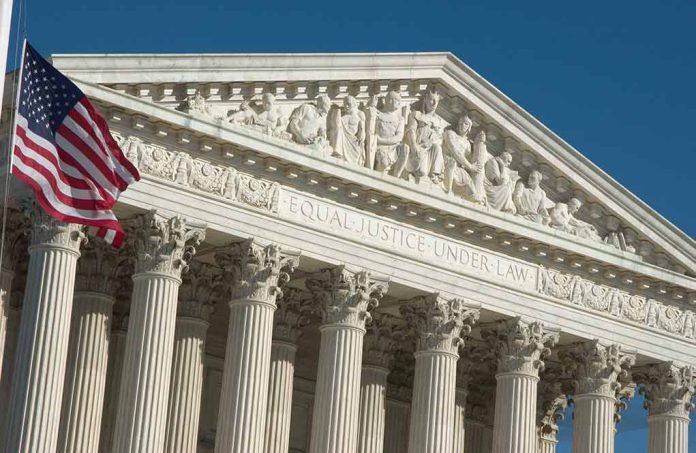
The Supreme Court upheld Biden-era ghost gun regulations in a 7-2 decision, requiring serial numbers and background checks for these previously untraceable weapons amid increasing criminal use.
Key Takeaways
- The Supreme Court voted 7-2 to uphold Biden administration regulations requiring serial numbers and background checks for ghost guns, with Justices Alito and Thomas dissenting.
- Ghost guns – privately assembled firearms without serial numbers – saw crime scene recoveries surge from fewer than 1,700 in 2017 to over 27,000 in 2023.
- The ATF’s 2022 classification of ghost gun kits as firearms under the 1968 Gun Control Act is now legally validated despite challenges from gun rights groups.
- Cities including New York, Los Angeles, Philadelphia, and Baltimore have reported stabilized or declining ghost gun recoveries since the regulation took effect.
- Justice Neil Gorsuch authored the majority opinion supporting the regulation of weapons that can be assembled in as little as 30 minutes.
Court Validates ATF Authority Over Unregistered Firearms
The Supreme Court delivered a significant victory for the Biden administration’s gun control efforts by upholding regulations on so-called “ghost guns” in a decisive 7-2 ruling. The decision, with only Justices Samuel Alito and Clarence Thomas dissenting, affirms the Bureau of Alcohol, Tobacco, Firearms and Explosives’ authority to classify ghost gun kits as firearms under the 1968 Gun Control Act. This classification means these previously unregulated weapons now require serial numbers, and buyers must undergo background checks – closing what many law enforcement officials considered a dangerous loophole in gun regulations.
Ghost guns present unique challenges for law enforcement because they lack serial numbers and can be purchased without traditional safeguards. Before this regulation, buyers could obtain these weapons anonymously online using cryptocurrency or pre-paid debit cards, effectively circumventing the established system of firearms tracking and accountability. The Court’s decision acknowledges that these kits, which can be assembled into functioning firearms in approximately 30 minutes, meet the legal definition of weapons that can be “readily converted” into operational firearms.
The Supreme Court upholds the ATF’s rule from the Biden administration restricting ghost guns.
Ruling was 7-2 with Neil Gorsuch delivering the opinion. Alito and Thomas dissent. pic.twitter.com/erregtvDJX
— Politics & Poll Tracker 📡 (@PollTracker2024) March 26, 2025
Crime Statistics Demonstrate Growing Threat
The ruling comes against a backdrop of alarming statistics that highlight the growing prevalence of ghost guns in criminal activity. According to data presented during the case, ghost guns recovered at crime scenes increased dramatically from fewer than 1,700 in 2017 to over 27,000 in 2023. This sixteen-fold increase underscores why law enforcement agencies and the Biden administration have prioritized regulating these weapons. The trend represents a significant shift in how criminals obtain and use firearms to avoid detection and prosecution.
Since the regulation took effect, authorities have observed promising developments in several major metropolitan areas. Cities including New York, Los Angeles, Philadelphia, and Baltimore have reported that ghost gun recoveries have either stabilized or begun to decline. This early evidence suggests the regulation may be achieving its intended effect of reducing the proliferation of these untraceable weapons in high-crime areas, potentially saving lives and helping solve violent crimes that might otherwise remain unsolved due to untraceable firearms.
Legal Challenges and Constitutional Concerns
The path to this Supreme Court decision has been contentious. After the ATF issued its rule in 2022, kit sellers and gun rights advocates quickly challenged the regulation, arguing that a collection of parts does not constitute a weapon under existing law. The conservative 5th Circuit Court of Appeals in Louisiana initially struck down the ATF rule, creating legal uncertainty that the Supreme Court has now resolved. Justice Neil Gorsuch, a Trump appointee, authored the majority opinion that ultimately sided with the government’s interpretation.
This decision marks a contrast with the Court’s recent ruling that struck down a Trump administration regulation banning bump stocks, devices that increase the firing rate of semi-automatic weapons. The differing outcomes highlight the Court’s case-by-case approach to firearms regulations rather than a broad ideological stance. Throughout the legal challenge, the Supreme Court had allowed the ghost gun rule to remain in effect, signaling its eventual decision to uphold the regulation and providing continuity in enforcement efforts.
Sources:
US Supreme Court upholds federal ‘ghost guns’ restrictions
Supreme Court upholds a Biden-era rule regulating ghost guns
Supreme Court upholds Biden rule requiring serial numbers and background checks for ghost guns













